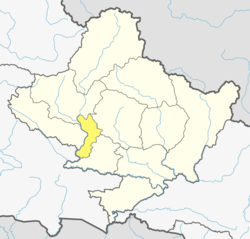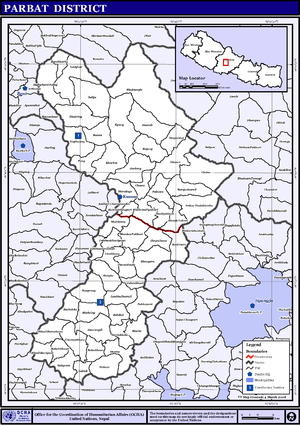Parbat District
Parbat District (Nepali: पर्वत जिल्ला![]()
Parbat District पर्वत | |
|---|---|
District | |
 Location of Parbat (dark yellow) in Gandaki Pradesh | |
| Country | |
| Province | Gandaki Pradesh |
| Government | |
| • Type | Coordination committee |
| • Body | DCC, Parbat |
| Area | |
| • Total | 494 km2 (191 sq mi) |
| Population (2011) | |
| • Total | 145,586 |
| • Density | 290/km2 (760/sq mi) |
| Time zone | UTC+05:45 (NPT) |
| Telephone Code | 067 |
| Website | www |
Geography and climate
Parbat district is a beautiful district with diversified geographical features. It extends from 280 00’ 19" N to 280 23’ 59" N latitude and 830 33’ 40" E to 830 49’ 30" E longitude
| Climate Zone[1] | Elevation Range | % of Area |
|---|---|---|
| Upper Tropical | 300 to 1,000 meters 1,000 to 3,300 ft. |
17.8% |
| Subtropical | 1,000 to 2,000 meters 3,300 to 6,600 ft. |
66.9% |
| Temperate | 2,000 to 3,000 meters 6,400 to 9,800 ft. |
14.0% |
| Subalpine | 3,000 to 4,000 meters 9,800 to 13,100 ft. |
1.4% |
Demographics
At the time of the 2011 Nepal census, Parbat District had a population of 146,590. Of these, 91.6% spoke Nepali, 4.1% Magar, 3.0% Gurung and 0.6% Newari as their first language.[2]
Political division
Entire Parbat district which had earlier 55 VDCs is now divided into 2 municipalities and 5 rural municipalities (gaunpalika) as listed below:
- Kushma Municipality
- Phalewas Municipality
- Jaljala rural municipality
- Paiyun Rural Municipality
- Mahashila Rural Municipality
- Modi Rural Municipality
- Bihadi Rural Municipality
Village development committees (VDCs) and municipalities

- Arthar Dadakharka
- Bachchha
- Bahaki Thanti
- Bajung
- Balakot
- Banau
- Baskharka
- Behulibas
- Bhangara
- Bhoksing
- Bhorle
- Bhuk Deurali
- Bhuktangle
- Bihadi Barachaur
- Bihadi Ranipani
- Pipaltari
- Chitre
- Chuwa
- Deupurkot
- Deurali
- Devisthan
- Dhairing
- Durlung
- Hosrangdi
- Huwas
- Karkineta
- Katuwa Chaupari
- Khola Lakuri
- Khurkot
- Kurgha
- Kushma Municipality
- Kyang
- Lekhphant
- Limithana
- Lunkhu Deurali
- Mallaj Majhphant
- Mudikuwa
- Nagliwang
- Pakhapani
- Pakuwa
- Pang
- Pangrang
- Phalamkhani
- Phalebas Devisthan
- Phalebas Khanigaun
- Ramja Deurali
- Saligram
- Salija
- Saraukhola
- Shankar Pokhari
- Shivalaya
- Taklak
- Tanglekot
- Thana Maulo
- Thapathana
- Thuli Pokhari
- Tilahar
- Tribeni
- Urampokhara
- Wahakithanti
- 7 Palika
See also
- Zones of Nepal
References
- The Map of Potential Vegetation of Nepal - a forestry/agroecological/biodiversity classification system (PDF), Forest & Landscape Development and Environment Series 2-2005 and CFC-TIS Document Series No.110., 2005, ISBN 87-7903-210-9, retrieved Nov 22, 2013
- 2011 Nepal Census, Social Characteristics Tables
- "Districts of Nepal". Statoids.
External links
| Wikimedia Commons has media related to Parbat District. |